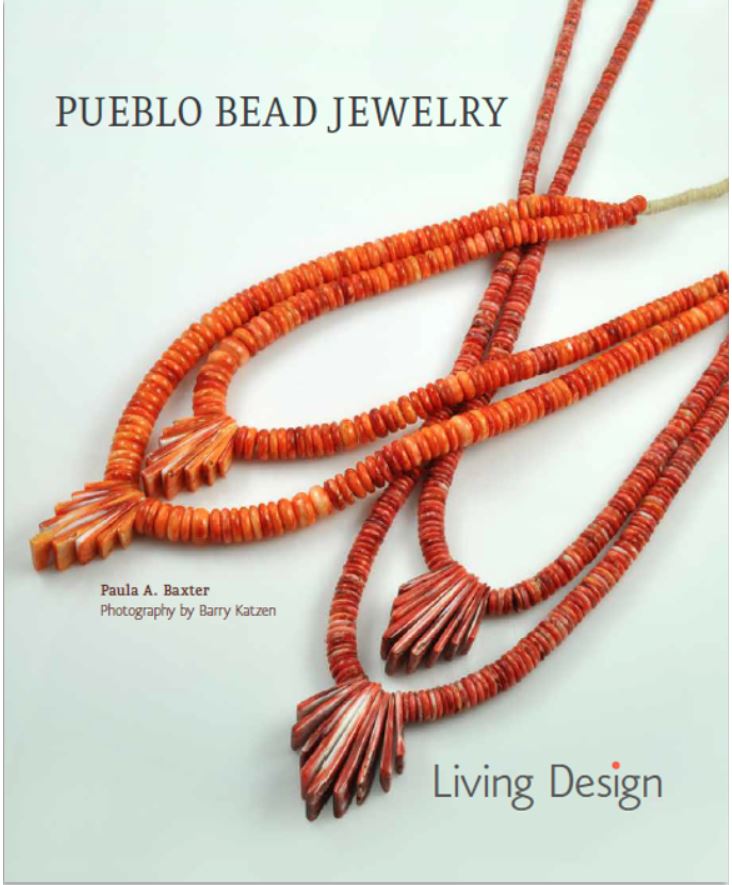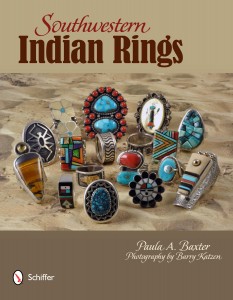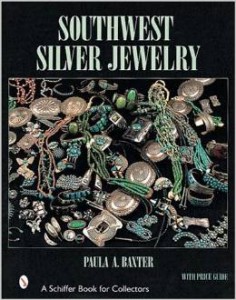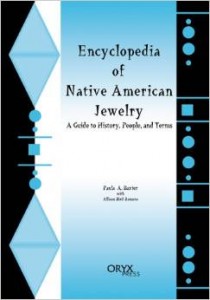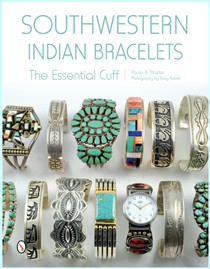This week we are in Phoenix — the Heard Guild Fair is this weekend, March 7 and 8. If you are anywhere near the Valley of the Sun and are interested in Native American arts and culture, definitely plan to attend. More than 600 American Indian artists will be there, from all around the country. Plus there’s music, dance performances, and craft demonstrations.
On Saturday we’ll be signing advance copies of our newest book, Southwestern Indian Bracelets: The Essential Cuff, near the Museum Bookstore.
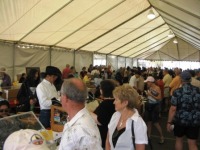 Inside one of the exhibition tents.
Inside one of the exhibition tents.
Public and popular culture recognition of the role Beadwork plays in Native American personal adornment was furthered by an influential exhibition “And the Bead Goes On!” at the San Diego Museum of Man. Held from April 1965 to February 1966, this exhibition reintroduced to the public the exquisitely detailed effects of beading. The curators drew careful distinctions between beadwork made solely for Native wear and items developed for sale to others.
Fact: This exhibition was important because it reinforced the understanding that Native artists have always retained creative control of their work. (See the exhibition catalog here.)
What has made the Indian arts market so wonderful over the past seventy years is that you could find good work in every price range, especially so with jewelry. Good quality Indian jewelry could be had at high quality costume jewelry prices, and as collectors developed their desires, they spent more if they believed in the artist and his/her aesthetic creativity. If prices show a disconnect between good design and materials, the buyer’s faith becomes eroded. At the same time, most collectors understand that materials costs and scarcity will affect prices, and they may have to pay a little more. Nevertheless, let’s be blunt: most arts, Indian or otherwise, are luxury goods. The makers of mainstream luxury goods like Vuitton and Prada can afford to raise their prices every year because their market will always have deep pockets. Can most Indian artists claim the same about all their customers?
As I get off the phone or e-mail with yet another concerned artist, I have to confirm that much consternation is being expressed over a splinter group of former SWAIA administors asking for an alternate version of the SWAIA Annual Indian Market.
Arts organizations around the U.S. have not done well in the aftermath of the Great Recession of 2008-9. SWAIA and IACA have undergone big changes in personnel and program planning. Indian arts can be considered luxury goods in a harsher economic environment. Many artists, collectors, and dealers are rightfully concerned about how viable the younger generation of collectors and consumers will turn out to be. Most collectors these days appear to belong to the age 40+ group…
Nevertheless, it’s important to look at the reasoning behind asking for a ninety-year-old tradition that has worked so well for so many to be broken or diminished in numbers. What exactly is to be gained by an alternative August Indian Market to be held over overlapping days to the regular Saturday and Sunday weekend, and in an unspecified location that may or may not be near downtown Santa Fe? When you begin to look at the individual artists who favor such a change, certain things become clearer. And I, among others, begin to feel concerned that certain media effects may have inadvertently encouraged divisions within the artistic ranks.
It seems the champions of this splinter show are those who may be considered “high end” in their status as artist. “High end” in this respect means those who can and do charge high prices for quality works which contain valuable materials and designs rendered with expertise and approval from the Indian arts market judging establishment. Many of these artists are at a point in their careers where art galleries are a better venue for their sales than the old-fashioned outdoor booth at SWAIA’s annual show. They may or may not have dealers who are ready to represent them, and plenty of collectors, including international consumers, who rush to purchase their latest creations. Are these artists going to do better in an Indian arts show which caters to their being part of a specific group with common features?
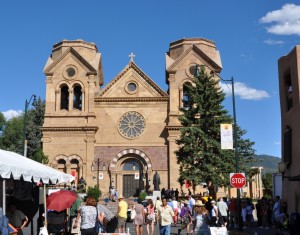 Santa Fe during Indian Market
Santa Fe during Indian Market
That’s a problem right there. Indian artists have endured too many years of competing with schlock souvenir goods that too many people see and think are legitimate. The years of discount sales, ones that still go on today at selected locations, have eroded buyer trust. When you bring those people who collect Indian arts but aren’t personally wealthy (like yours truly) to Indian Market, they aren’t looking for a bargain, but they are looking for something they can spend their money on with pride and pleasure. Why should those who can afford high end arts be the only ones who can count on getting value for their money? Collectors are better educated than they used to be.
(Part 3 of a series)
 Santa Fe Cathedral during Indian Market
Santa Fe Cathedral during Indian Market
Like the Covered Wagon in Old Town, Skip Maisel’s store in downtown is one of the most famous curio shops along Route 66. Indian-made jewelry from Maisel’s shop, even though much was bench-produced, serves as popular vintage collectibles. The store is still going strong today and acts as many tourists’ introduction to souvenir Indian arts. Works by notable jewelers figure in the front cases, but the real goods—lots and lots of them—are the mass-produced necklaces, bracelets, pendants, and rings that line the aisles.
As always, what’s unfortunate is that these goods can be perceived as representing what genuine Indian-made arts are like. The fact is that curio jewelry usually is stuck in a mid-20th century stylistic time warp, reflecting designs that are called “traditional” and “classic.” In my forthcoming book, Southwestern Indian Bracelets: The Essential Cuff, I’ll be examining what really lies behind these labels and why they denote value judgments both good and bad.
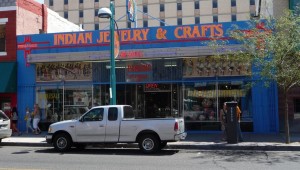 Maisel’s Indian Jewelry & Crafts store, Albuquerque
Maisel’s Indian Jewelry & Crafts store, Albuquerque
This question has often come up over the years. This year, we were in a position to attend and pulled into the parking lot for the Friday August 9 day of the annual event. There were a lot fewer cars than we remembered. An immediate disappointment arose when we bought our tickets and learned that the powwow had been canceled. The booths along the perimeter of the buildings had Natives selling stuff that was definitely NOT locally made. Inside, things seemed back to normal except for the fact that the interior booths were reduced to a very small number. I remember when the booths lined the entire perimeter of the great hall.
Can we blame the recession? Yes, but there seems to be a more complex string of issues. Those who run and organize the Ceremonial have been plagued by fundraising woes. I recall about five years ago they turned to the state for funding solutions. Ooops! One reality is that the number of active trading posts with powerful followings of artists and collectors has greatly diminished. Trading posts are not what they once were, and Hubbell Trading Post in Ganado AZ may soon be one of the few real remaining relics of this enterprise.
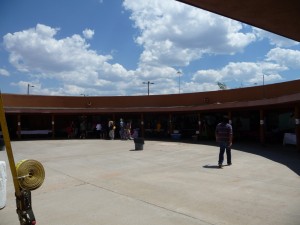 The outdoor booths at the Gallup Inter-Tribal Ceremonial.
The outdoor booths at the Gallup Inter-Tribal Ceremonial.
Bruce Bernstein, the Director of SWAIA, has had a long and distinguished career in the world of Indian arts. His scholarship is top-notch. I recently reread a piece by him in an anthology, Native American Art in the Twentieth Century: Makers, Meanings, Histories. In doing research for my next book on Southwestern Indian bracelets, I found an article he’d contributed to the anthology on how the 1960s and 1970s provided new contexts for Indian arts. Bernstein pointed out the start of an international profile for Indian artists, including foreign exhibitions for selected individuals. He describes how changes in the American social and intellectual climate helped make Native American Studies an academic discipline.
My own education in the first half of the 1970s occurred too early to benefit from this. My dual major of art history and anthropology of the North American Indian (a mouthful) shows how great the emphasis on anthropology still was at that time. The creation of Native American Studies helped usher in a multidisciplinary — and interdisciplinary — approach to Native art production. Bernstein also wisely points out that the “traditional” arts with their handcrafted nature made them popular in America in general. Even their introduction into home decoration played a role we still recognize today.
Looking over the winning entries for the juried competition award list for the 2012 Heard Museum Guild Indian Fair and Market, I see some titles that inspire chuckles and giggles. I’ve always enjoyed the sly nature of Indian humor, from Fritz Scholder to Diego Romero. A people who have decried their stereotyping often prove resilient in gaining revenge. Some of the winners of this year’s competition have had no compunction about mocking our contemporary society and its obsessions:
- Best of Class for Classification IV Wooden Carvings was “Techno Kid on the Run” by Stetson Hunyumptewa. A Hopi koshare pursues a naughty boy who is preoccupied with his smart phone and apps.
- In the non-traditional Baskets Classification, Pauline Tsosie produced a delight entitled “Paradigm Shift.”
- Two winners in the Mixed Media Classification were titled “Vexations” and “Power Struggle,” reminders that the days of “Bambi School of Art” prettiness are resoundingly rejected.
Will it be true that our 21st century is known as “The Age of Cynicism” by Natives and non-Natives alike?

Navajo weavings are a wonderful category of Indian-made art. These textiles, old and new, bear testimony to the artist’s eye for small details that pack a punch. Like clouds and scenes from reservation life, a weaving can come alive when animals are introduced. The tree of life weavings come to mind at once, but then there are those compositions that portray the sturdy chipmunk, carefree Kaibab squirrel, or anxious cottontail. One of my favorite categories is the pictorial weaving, where the introduction of animals makes the entire composition that much livelier. We were fortunate in the late 1980s to obtain a small weaving by the artist Fanny Pete that consists entirely of rabbits! It’s the pride of our home and I’d never let our amazingly spoiled bunnies anywhere near it. For those of you unacquainted with domestic rabbits—they chew textiles like puppies…
